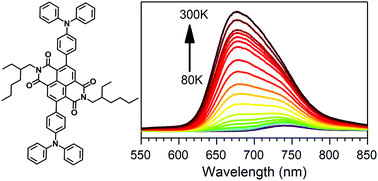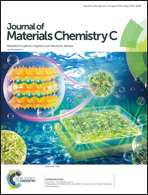Triphenylamine disubstituted naphthalene diimide: elucidation of excited states involved in TADF and application in near-infrared organic light emitting diodes†
Abstract
It is demonstrated that a naphthalene diimide core disubstituted with triphenylamine can be used as a thermally activated delayed fluorescence emitter in organic light emitting diodes. Detailed spectroscopic studies demonstrated unusual host effects on the photophysical properties of this material. In particular, we were able to deduce recombination pathways and the role of the host and temperature in increasing/decreasing the TADF contribution in overall emission. Furthermore, stemming from these host effects on the geometry of the emitter we discover different local triplet states involved in the TADF mechanism. We elucidate this confusing situation to show that simply measuring low-temperature phosphorescence does not always give the energy of the local triplet involved in TADF. The studies carried out in a non-polar polymer and the OLED host were completed by NIR OLED fabrication showing promising characteristics.



 Please wait while we load your content...
Please wait while we load your content...